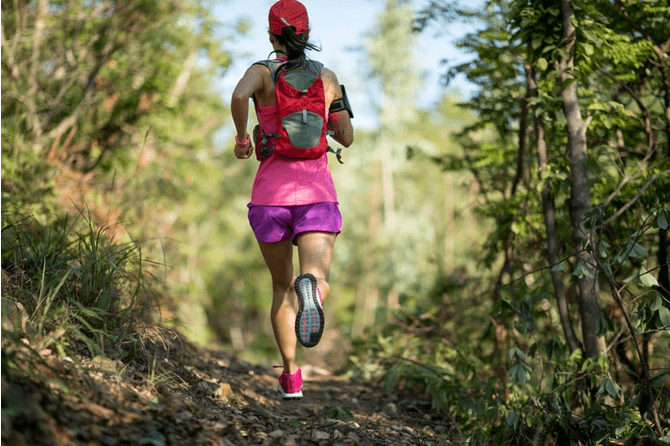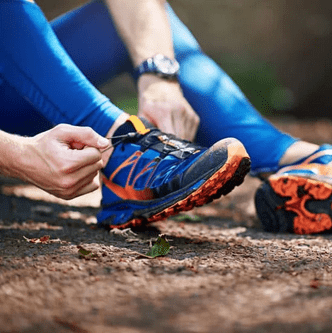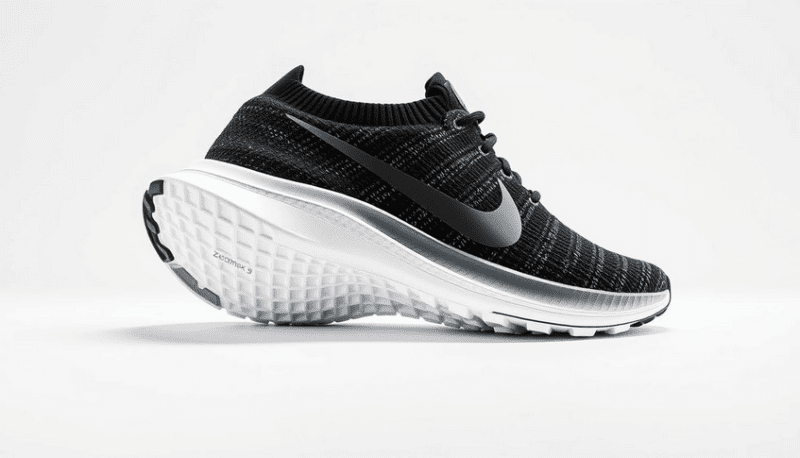Trail running is getting more popular, and it's time to hit the trails. It requires endurance, strength, agility, and good preparation. This article will give tips for improving your trail running and getting ready for races. It's for both new and experienced runners.
We'll talk about avoiding mistakes and how to prepare for tough races up to 330 kilometers.

Key Takeaways
- Develop a strong aerobic base through varied terrain and elevation training.
- Incorporate strength exercises to build leg and core strength for the demands of trail running.
- Refine your uphill and downhill running technique to improve efficiency and reduce injury risk.
- Gradually increase your trail running distances to build endurance and prepare for longer races.
- Prioritize proper nutrition and hydration strategies to fuel your trail running adventures.
Introduction to Trail Running Training
Trail running is more than just running on roads. It's a way to challenge your fitness and enjoy nature's beauty. Whether you're experienced or new, knowing the benefits and how to prepare can make your journey fun and successful.
The Benefits of Trail Running
Trail running boosts fitness and well-being in many ways. It improves endurance, strength, agility, and balance. Running on trails with hills and uneven ground strengthens your core and legs. Plus, the beautiful scenery can make you feel less stressed and happier.
Essential Preparations for Trail Running Training
Getting ready for trail running is important for safety and fun. Here are some tips to remember:
- Build a Solid Aerobic Base: Work on your heart health by training regularly. Slowly increase how far and hard you run.
- Strength Training: Do exercises that focus on your legs, core, and stabilizing muscles. This will help you handle trail running better.
- Agility and Balance: Practice agility drills and balance exercises. This will help you move smoothly over rough terrain and adjust to changing trail conditions.
- Familiarize Yourself with the Terrain: Learn about the trails you plan to run, including the hills, stairs, and different surfaces you'll encounter.
Understanding trail running's benefits and preparing well will help you start a rewarding journey. You'll find it transformative.
Building a Solid Aerobic Base
Building a strong trail running aerobic base is key for trail success. It means doing long, moderate-intensity workouts on tough terrain and steep hills. This boosts your heart health. Adding different activities like flat running, mountain walks, cycling, and trekking helps build a strong base for trail running.
Incorporating Varied Terrain and Elevation
Running on varied terrain and elevation prepares your body for trail challenges. This training improves heart fitness, strengthens muscles, and boosts balance. It also makes you a better trail runner.
- Incorporate flat terrain running to build a solid aerobic base.
- Challenge yourself with mountain fast-paced walks to simulate the demands of trail running.
- Engage in cycling and trekking to cross-train and develop a well-rounded fitness profile.
Spending time on varied terrain and elevation training prepares you for the trails' surprises. It also keeps your aerobic base strong during trail running.
"Embracing the diversity of terrain and elevation in your training is the key to unlocking your full potential as a trail runner."
Strength Training for Trail Runners
Trail running is tough and needs more than just heart health. Strength training is key for building leg power, core stability, and body control. Adding strength exercises to your routine boosts your running and lowers injury risks.
Leg Strengthening Exercises
For strong legs in trail running, focus on exercises for your lower body. Squats, lunges, and calf raises build strength for steep hills and tricky descents. Vertical jumps and plyometric exercises boost explosive power for obstacles and tough terrain.
Core and Stability Exercises
Core and stability training are vital for trail runners. They help you keep good form and move smoothly over rough ground. Try forward jumps, side-to-side jumps, and single-leg balance drills to improve your quick reactions and stability.
| Exercise | Target Muscle Groups | Benefits for Trail Runners |
|---|---|---|
| Squats | Quadriceps, Glutes, Hamstrings | Improved leg strength and power for climbing |
| Lunges | Quadriceps, Glutes, Hamstrings | Enhanced balance and stability for navigating uneven terrain |
| Calf Raises | Calves | Increased ankle and lower leg strength for downhill running |
| Forward Jumps | Quadriceps, Glutes, Core | Improved agility and body control for technical trail sections |
| Single-Leg Balance Drills | Core, Stabilizer Muscles | Enhanced balance and stability for navigating obstacles |
Adding leg and core exercises to your trail running plan helps you meet the trail's challenges with confidence and skill.
Trail running training
Learning how to run uphill and downhill is key to success in trail running. Using the right technique makes you more efficient and lowers your chance of injury. We'll look at some drills to help you improve your running on steep hills and down steep slopes.
Uphill Running Technique Drills
Keep your posture right when running uphill, engage your core, and use your leg muscles well. Here are some drills to improve your uphill running:
- Hill Repeats: Run up a hill, keeping your knees high and keeping a steady pace. Do this a few times to get stronger and more enduring.
- Uphill Strides: Sprint up a steep hill, focus on a strong leg push, and lean forward a bit. Walk back down, then do it again a few times.
- Plyometric Uphill Drills: To boost power and quickness, add explosive moves like box jumps or lateral bounds to your training.
Downhill Running Technique Drills
Running downhill needs skills, like staying in control, balanced, and knowing how to slow down. Try these drills to get better at downhill running:
- Controlled Descents: Run down a hill, lean forward, and use your core and legs to control your speed.
- Zig-Zag Downhill Drills: Run zig-zag down a hill to work on balance and quick turns.
- Braking Drills: Find a steep spot and practice slowing down with your legs, hips, and core. Don't let yourself go too fast.
Adding these drills to your training will improve your handling of trail ups and downs. Remember, practice often and keep your form right to become a more skilled and confident trail runner.

Increasing Trail Running Distances
Endurance training for trail running is key to fitness growth. As you progress in your trail running, it's important to increase the distance and difficulty. This will help you build stamina and resilience for tougher trails.
Begin with short trail runs, from 0 to 45 kilometers. This builds a strong aerobic base and gets you used to trail running's demands. Then, increase the distance, adding varied terrain and elevation changes as you get more comfortable.
- Short Trails (0-45 km): Build a strong aerobic foundation and learn to navigate different trail conditions.
- Medium Trails (45-80 km): Challenge yourself with longer distances, steeper inclines, and technical terrain.
- Long Trails (80-150 km): Develop supreme endurance and master the art of pacing and fueling for extended efforts.
- Extreme Ultra Trails (150 km and beyond): Test your physical and mental strength limits, tackling even the most daunting trail distances.
Increasing your trail running distance should match proper nutrition, injury prevention, and mental strength training. This approach will help you sustain and succeed as you push your endurance limits.
| Trail Distance | Elevation Gain | Estimated Time |
|---|---|---|
| 0-45 km | 500-1,500 m | 3-8 hours |
| 45-80 km | 1,500-3,000 m | 8-15 hours |
| 80-150 km | 3,000-6,000 m | 15-30 hours |
| 150 km and beyond | 6,000 m+ | 30 hours+ |
The key to increasing your trail running distance is to do it step by step. Listen to your body and celebrate your progress. Embrace the journey and let your endurance grow.
Nutrition and Hydration for Trail Runners
Trail runners need nutrition and hydration to perform well and stay healthy. This section covers how to fuel up before running and how to replenish electrolytes. It's all about giving your body what it needs for trail running.
Pre-run Fueling Strategies
Before you start running, fuel your body with the right nutrients. Carbohydrates give you energy, so eat foods high in complex carbs like whole grains, fruits, and veggies. This helps you have enough glycogen for your run.
Don't forget to add some protein to your pre-run meal or snack. Protein helps with muscle recovery and repair. Good options include oatmeal with berries and nut butter, a whole-grain bagel with nut butter and banana, or a smoothie with Greek yogurt, fruit, and spinach.
Hydration and Electrolyte Replenishment
It's key to stay hydrated and replenish electrolytes lost through sweat. Carry a hydration pack or water bottle to keep fluids handy during your run.
For electrolyte replenishment, use sports drinks, tablets, or gels, and salty snacks. These help replace sodium, potassium, and other minerals lost through sweat. Listen to your body and adjust your hydration and electrolyte intake to avoid muscle cramps and fatigue.
| Nutrient | Recommended Intake for Trail Runners |
|---|---|
| Carbohydrates | 30-60 grams per hour of activity |
| Protein | 10-20 grams within 30 minutes of finishing a run |
| Fluids | 0.5-1 liter per hour, adjusting based on sweat rate and environmental conditions |
| Electrolytes (sodium, potassium, etc.) | Vary based on sweat rate and duration of activity, but generally 300-700 mg of sodium per hour |
Essential Gear for Trail Running
Trail runners need the right gear for longer distances and tough terrain. Trail running shoes and accessories are key for performance, safety, and comfort. This guide will help you pick the best gear for a great trail running experience.
Trail Running Shoes
Choosing the right trail running shoes is vital. Think about the type of running, the terrain, and how far you'll go. Look for shoes with good grip, cushioning, and stability to protect your feet on rough trails.
Hydration Packs and Accessories
For longer runs, staying hydrated and having the right gear is crucial. Get a quality hydration pack for your water, drinks, and snacks. Don't forget about trekking poles, headlamps, and GPS watches to help with safety, finding your way, and doing your best.
| Essential Trail Running Gear | Benefits |
|---|---|
| Trail Running Shoes | Provide grip, cushioning, and stability on uneven terrain |
| Hydration Pack | Carry water, electrolyte drinks, and snacks for long-distance runs |
| Trekking Poles | Improve stability and reduce the impact on descents |
| Headlamp | Ensure visibility and safety during early morning or evening runs |
| GPS Watch | Track distance, pace, and elevation changes for performance analysis |
Choosing the right trail running gear and accessories can greatly improve your experience. It boosts your performance, safety, and fun on the trails.
Conclusion
Trail running is exciting and rewarding, but it needs careful planning and training. This article gives readers the tools to start their trail running journey, whether they're new or experienced. It's all about physical training, choosing the right gear, and staying mentally strong.
The training tips mentioned here will boost any runner's skills. They cover building a strong base, mastering hills, and more. Adding strength training and smart nutrition will also help runners stay strong and avoid injuries.
As you begin or continue your trail running, remember you have the knowledge and tools to excel. Embrace the challenges and enjoy the beauty of nature. Trail running can bring a sense of achievement and a closer bond with nature. So, put on your trail shoes and get ready for an amazing adventure!
FAQ
Q: What are the key benefits of trail running?
A: Trail running boosts endurance, strength, and agility and improves aerobic base and fitness level.
Q: What are the essential preparations for trail running training?
A: Key preparations include building a strong aerobic base and doing strength training. It's also important to work on agility and balance. Plus, get familiar with mountainous terrain.
Q: How can I develop a strong aerobic base for trail running?
A: Start with long, moderate-intensity workouts on rough terrain and steep hills. Mix in flat runs, mountain walks, cycling, and trekking to build your aerobic base.
Q: What strength training exercises are important for trail runners?
A: Focus on exercises like squats, lunges, calf raises, and vertical jumps. Also, try stability exercises like lateral lunges and single-leg squats to improve balance and control.
Q: How can I improve my technique for uphill and downhill running on trails?
A: Maintain good posture, position your knees correctly, and balance well. Use drills and exercises to improve your climbing and descending of steep trails.
Q: How can I safely increase my trail running distances?
A: Gradually increase your distance, elevation, and difficulty level. Remember to focus on good nutrition, injury prevention, and mental strength during this process.
Q: What are the key nutrition and hydration considerations for trail runners?
A: Good nutrition and hydration are key for trail runners. Eat the right foods before workouts and recover well after. Keep hydrated and balanced with electrolytes.
Q: What type of gear is important for trail running?
A: Choose the right trail running shoes for performance and safety. High-quality technical clothes, hydration packs, and GPS watches can also improve your runs.
Q: What additional gear is recommended for longer and more challenging trail running events?
A: Consider using hydration packs and trekking poles for longer and tougher runs. They can make you safer, perform better, and stay more comfortable.
DISCLAIMER
The information on Save on Sneaks and our related pages is provided for entertainment and informational purposes only. It is not intended as a substitute for the advice of or treatment that your physician or other health care provider may prescribe.
Understand that you are solely responsible for how this information is perceived and utilized, and do so at your own risk. In no way will Save on Sneaks be responsible for injuries or other problems that might occur due to the use of this website or any actions taken based on the content of this website. Save on Sneaks will not be held responsible for the conduct of any companies and websites recommended within this site.
Before adhering to any of the information or recommendations or undertaking any exercise program or diet regimen, you should consult your physician.




